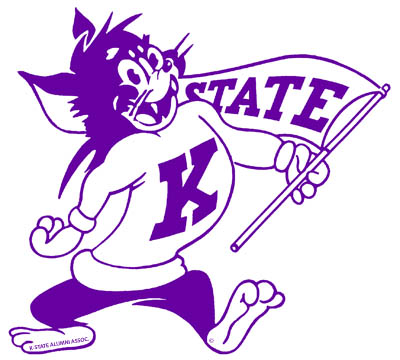
(with the little-known 2nd and 3rd verses) I know a spot that I love full well,
Hail to the purple!
From the great Atlantic Ocean If you lived through the Great Depression, you might remember the "Wabash Cannonball" as one of the country's most resonant songs from that era -- a spirited ballad about a legendary locomotive. If you are from Indiana, you might know "Wabash Cannonball" because of its reference to a well-known river in the Hoosier State. If you're a fan of Roy Acuff, you might recognize it as the biggest-selling recording of his career. But how in the world did "Wabash Cannonball", composed in 1933, become the most popular song with sports fans at Kansas State University, three states to the west of the namesake river? How did a tune saluting the nation's rail-riding hobos -- from 60 years ago -- come to be the unofficial fight song for the Wildcats' athletics events? The answer seems to lie somewhere between coincidence and fate. "Back in 1960s, there was a lot of unrest on college campuses around the country," said K-State sports information director Kent Brown. "On the night of Dec. 13, 1968 -- Friday the 13th, to be exact -- arsonists struck at K-State, targeting Nichols Hall, one of the most prominent buildings on the 668-acre campus and home to the school's music department. Everything was destroyed, including 20 Steinway grand pianos, dozens of band instruments and all the sheet music." "The only thing that survived was the band director's briefcase because he took it home with him, and the only music he had in the case was 'Wabash Cannonball,' " said Brown. "No fight song, no alma mater music, no instruments." With the next basketball game against Syracuse at Ahearn Field House only three days away, desperation (if not panic) had set in by Monday morning. That's when band director Phil Hewett broadcast an appeal on KSAC, the university's radio station, asking area school districts for castoff and extra musical instruments. "So the band members ended up driving all over the state, in every direction," said Brown. "They picked up everything from tubas to trumpets to be ready for the game that night." With little more than 20 minutes before tip-off and less than one-third of the musicians on hand, the 14 band members slipped the only sheet music they had into their lyres and played the "Wabash Cannonball" for the first time. They have been playing it ever since. "The crowd went wild for some reason, maybe because of the fire," said Brown. "You know, I've heard a few renditions of the Cannonball at other schools and it's just doesn't have the same sound. I don't know what it is about the way our band at K-State plays that song, but it just has a special something that other bands don't quite get." Maybe it's because of the singular story itself -- how a traditional song from the Depression was salvaged from a disastrous fire and became a very untraditional fight song at Kansas State. Or maybe it's in appreciation for the spirit of a few dedicated people who played the same song over and over one night more than 30 years ago, starting a tradition that should endure at Kansas State for years to come. Here's the K-State student section demonstrating the Wabash tradition vs. Texas at home, on 9/29/18, as posted to YouTube by College Football America.
The text below is a beloved part of our current Ceremony of Allegiance. It is used as a voice-over by the K-State Marching Band's announcer as the beautiful music plays. It begins with the Preamble to the United States Constitution. Next is the first sentence of paragraph two of the Declaration of Independence, followed by the last sentence of the Declaration. The voice-over concludes with the Pledge of Allegiance. For many years, some language in the Ceremony of Allegiance differed slightly from the actual Declaration of Independence. For example, the ceremony used the more modern word inalienable instead of unalienable, which is in the Declaration. Also, the Declaration's actual words are "we mutually pledge to each other," while to each other was not included in the Ceremony until recent years. Regardless, it's a great, long-standing tradition that is a tremendous introduction to playing our National Anthem. We the People of the United States, in Order to form a more perfect Union, establish Justice, insure domestic Tranquility, provide for the common defense, promote the general Welfare, and secure the Blessings of Liberty to ourselves and our Posterity, do ordain and establish this Constitution for the United States of America.
This is from The Pride of Wildcat Land's history web page: Wildcat March: In October, 1928, John Philip Sousa was to make an appearance at K-State. A petition, signed by most of the student body, was presented to Sousa on October 10, 1928, requesting that he compose a Kansas State Agricultural College march. The piano arrangement of Kansas Wildcat March arrived at the Music Department in the spring of 1931, and is now an integral part of the pre-game show at every football game. Wildcat March is normally one of the selections you will hear the "Pride" playing in each of the parades they march in every year.
What's the history behind the "WC" sign Cats fans display at games? It's thought to have come from The Pride of Wildcat Land. The proper procedure is to display it with the right hand. Here's a story on the subject from the March 6, 2020 Manhattan Mercury. Shown below is Shelby Wallace, K-State's greatest cheerleader ever, with the WC back in June 2014. (By the way... June is Shelby's middle name, and her name now is Shelby June Haddam.)

(who has attended every football game since 1973) 
Robert J. Lipson
|

